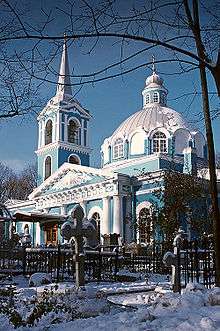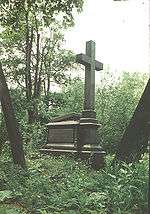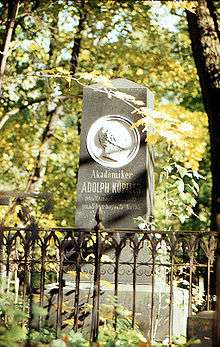Smolensky Cemetery
Coordinates: 59°56′36″N 30°14′55″E / 59.94333°N 30.24861°E
.jpg)
Smolensky Cemetery (Russian: Смоленское кладбище) is the oldest continuously operating cemetery in Saint Petersburg, Russia.[1] It occupies a rectangular parcel in the western part of Vasilievsky Island, on the bank of the small Smolenka River, and is divided into the Orthodox, Lutheran, and Armenian sections.
Orthodox cemetery
The Orthodox cemetery is known to have existed in 1738,[1] but was not officially recognized until 1758.[2] Not only was it far removed from the city center, but it was also damp, necessitating the construction of drainage canals.[3]
The cemetery has two churches. The older church is dedicated to the Theotokos of Smolensk. The azure-painted Neoclassical building was erected between 1786 and 1790. The church was closed for worship by the Bolsheviks between 1940 and 1946, then between 1960 and 1987.[3] The newer church (1904), currently in disrepair, is dedicated to the Resurrection of Christ. It is the only example of Naryshkin Baroque in Saint Petersburg. The church used to be known for its dazzling Neo-Baroque icon screen with a set of Vasnetsov icons. Other buildings on the grounds included the first wooden church, that of Michael the Archangel (destroyed by the Saint Petersburg flood of 1824), and an almshouse designed by Luigi Rusca.
The cemetery was a traditional burial place for the professors of the Imperial Academy of Arts and St. Petersburg University (both sited on Vasilievsky Island).[2] Up to 800,000 people are estimated to have been interred at Smolensky Cemetery before the Russian Revolution, making it the largest 19th-century cemetery of Saint Petersburg.[3] Interments included:
- Xenia of Saint Petersburg, the patron saint of the city; her tomb is marked by a chapel.
 The Smolensky Church (1786-90) is dedicated to the Theotokos of Smolensk
The Smolensky Church (1786-90) is dedicated to the Theotokos of Smolensk - Vasily Trediakovsky (1769)
- Mikhail Kozlovsky (1802)
- Andreyan Zakharov (1811)
- Elisabeth Kulmann (1825)
- Dmitry Bortniansky (1825)
- Ivan Martos (1835)
- Taras Shevchenko (1861, reburied on Chernecha Hora near Kaniv)[4]
- Nikolay Ustryalov (1870)
- Vasily Karatygin (1880)
- Nikolay Zinin (1880)
- Ivan Kramskoi (1887)
- Alexander Mozhaysky (1890)
- Ivan Shishkin (1898)
- Arkhip Kuindzhi (1910)
- Nikolay Beketov (1911)
- Pyotr Semyonov-Tyan-Shansky (1914)
- Leonid Pozen (1921)
- Alexander Blok (1921)
- Alexander Friedmann (1925)
- Fyodor Sologub (1927)
- Fyodor Uspensky (1928)
- Nikolay Likhachyov (1936)
- Boris Piotrovsky (1990)
After the Russian Revolution the local authorities announced plans to demolish the cemetery by 1937, replacing it with a public garden "for sanitation's sake".[3] Entire tombs or their sculptural details were moved to museums in order to preserve them.[3] The remains of Kozlovsky, Zakharov, Martos, Bortniansky, Karatygin, Kramskoi, Shishkin and Kuindzhi were transferred to the Alexander Nevsky Lavra. Alexander Blok was the last to be reburied in 1944. The outbreak of the Second World War put these plans on hold. The cemetery was eventually reopened for select burials in the early 1980s.[1]
Lutheran cemetery
The Lutheran cemetery on Dekabristov Island is known to have existed in 1747. The minor Smolenka River separates it from the eponymous Orthodox cemetery. This cemetery contained the burials of the parishioners of the Evangelical Lutheran Church of Saint Katarina and the Catholic Church of Saint Catherine,[1] including Leonhard Euler, Germain Henri Hess, José de Ribas, Vasily Dokuchayev, Moritz von Jacobi, Agustín de Betancourt, Jean-François Thomas de Thomon, Fyodor Nikolajewitsch Litke, Xavier de Maistre, Ludvig Nobel, Georg Friedrich Parrot, Karl Nesselrode, and Vladimir Lamsdorf. In the 20th century, several parts of the cemetery were destroyed; the remains of Euler and Betancourt were reburied in the Alexander Nevsky Lavra.[1]
 The grave of Karl Nesselrode
The grave of Karl Nesselrode The grave of Adolph Theodor Kupffer
The grave of Adolph Theodor Kupffer The grave of Fyodor Nikolajewitsch Litke
The grave of Fyodor Nikolajewitsch Litke The grave of José de Ribas
The grave of José de Ribas
Armenian cemetery
The Armenian section of the cemetery has a church consecrated in 1797. The architect was probably Georg Veldten.[1]
References
| Wikimedia Commons has media related to Smolensk Orthodox cemetery. |